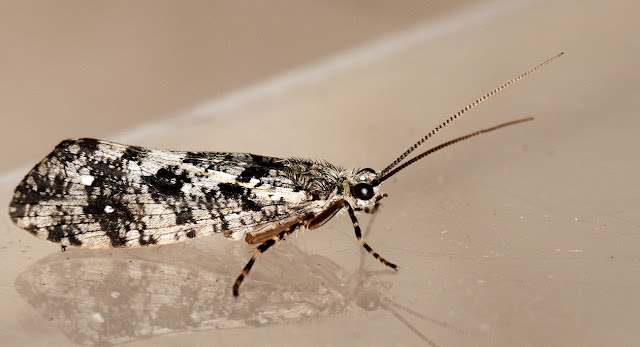 |
| Midge, probably Chironomus luridus. Kelsey Park, 28 August 2015. |
There are usually two bat walks in Kelsey Park (Beckenham) each year. You have to book for them because they are so popular; the best bat walk in the area, because there you can see Daubenton's bats skimming over the water. For the last three years I have put out my moth trap during the August walk to see what might be around.
Results have been very varied. Even on good moth nights, the walk is usually finishing before many moths have arrived. This year, an extra walk was put on to cope with demand, but the second was on a cool damp night and almost nothing turned up in the trap (but there were plenty of bats over the lake).
However, during the first August walk I saw the usual flush of midges large and small. This was one of the larger ones. It's not a biter - no long proboscis is visible. The name I have attached to it is only tentative. A similar creature was identified as this last year.
We also had some Caddises.
 |
| Caddis, Speckled Peter, Agrypnia varia. Kelsey Park, 28 August 2015. |
This black-and-white Speckled Peter was the prettiest. You can expect to see lots of Caddisflies around water because that's where their larvae live.
 |
| Water Boatman, probably a Callicorixa species. Kelsey Park, 28 August 2015. |
This is another sign of nearby water; a beetle, actually a true bug, called a Water Boatman because of the way it uses its legs to swim around under the water. They look rather like oars. Most people don't realise that these creatures also fly around at night. We had several in the light trap.
 |
| Forest Bug, Pentatoma rufipes. Kelsey Park, 28 August 2015. |
Forest Bugs also tend to come to light. These are also true bugs, but have nothing to do with the nearby water. They live in trees.
While looking around I also saw this Harvestman on a Scots Pine.
 |
| Harvestman, order Opiliones. Kelsey Park, 28 August 2015. |
Harvestmen are related to spiders, but have only a single body segment, whereas spiders have two. I often see them when trapping at night. They don't usually come to the light, but they are always wandering around so I see them coming and going. Most species have long legs, some much longer than this, though a few are more compact. They are one of the groups of creatures called Daddy Long-legs. Craneflies and some spiders also get that name.
Next time I will show some actual moths!





Great photographs. I would like to use your speckled Peter photograph on our blog at springfieldmn.blogspot.com if you agree. You can reach me at rekipfer@gmail.coom
ReplyDelete